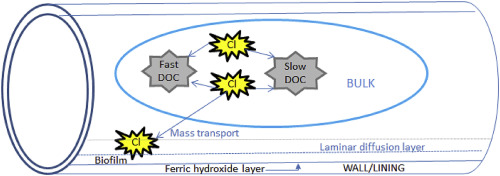当前位置:
X-MOL 学术
›
Water Res.
›
论文详情
Our official English website, www.x-mol.net, welcomes your
feedback! (Note: you will need to create a separate account there.)
New model of chlorine-wall reaction for simulating chlorine concentration in drinking water distribution systems
Water Research ( IF 11.4 ) Pub Date : 2017-08-30 , DOI: 10.1016/j.watres.2017.08.066 Ian Fisher , George Kastl , Arumugam Sathasivan
Water Research ( IF 11.4 ) Pub Date : 2017-08-30 , DOI: 10.1016/j.watres.2017.08.066 Ian Fisher , George Kastl , Arumugam Sathasivan

|
Accurate modelling of chlorine concentrations throughout a drinking water system needs sound mathematical descriptions of decay mechanisms in bulk water and at pipe walls. Wall-reaction rates along pipelines in three different systems were calculated from differences between field chlorine profiles and accurately modelled bulk decay. Lined pipes with sufficiently large diameters (>500 mm) and higher chlorine concentrations (>0.5 mg/L) had negligible wall-decay rates, compared with bulk-decay rates. Further downstream, wall-reaction rate consistently increased (peaking around 0.15 mg/dm2/h) as chlorine concentration decreased, until mass-transport to the wall was controlling wall reaction. These results contradict wall-reaction models, including those incorporated in the EPANET software, which assume wall decay is of either zero-order (constant decay rate) or first-order (wall-decay rate reduces with chlorine concentration). Instead, results are consistent with facilitation of the wall reaction by biofilm activity, rather than surficial chemical reactions. A new model of wall reaction combines the effect of biofilm activity moderated by chlorine concentration and mass-transport limitation. This wall reaction model, with an accurate bulk chlorine decay model, is essential for sufficiently accurate prediction of chlorine residuals towards the end of distribution systems and therefore control of microbial contamination. Implementing this model in EPANET-MSX (or similar) software enables the accurate chlorine modelling required for improving disinfection strategies in drinking water networks. New insight into the effect of chlorine on biofilm can also assist in controlling biofilm to maintain chlorine residuals.
中文翻译:

模拟饮用水分配系统中氯浓度的氯-壁反应新模型
整个饮用水系统中氯浓度的准确模型需要可靠的数学描述,以说明散装水和管壁中的衰减机理。根据现场氯剖面和精确模拟的体积衰减之间的差异,计算了三种不同系统中沿管道的壁反应速率。与大体积腐烂率相比,具有足够大直径(> 500 mm)和较高氯浓度(> 0.5 mg / L)的衬里管的腐烂率可忽略不计。在更下游,壁反应速率持续增加(峰值约为0.15 mg / dm 2)/ h),随着氯浓度的降低,直到质量传递到壁上控制了壁反应。这些结果与壁反应模型(包括EPANET软件中包含的模型)相矛盾,后者假定壁衰减为零阶(恒定衰减率)或一阶(壁衰减率随氯浓度降低)。相反,结果与通过生物膜活性而不是表面化学反应促进壁反应一致。一种新的壁反应模型结合了氯浓度和传质限制对生物膜活性的影响。该壁反应模型具有准确的总氯衰减模型,对于在分配系统的末尾充分准确地预测氯残留物并因此控制微生物污染至关重要。在EPANET-MSX(或类似软件)软件中实施此模型可以实现改善饮用水网络消毒策略所需的精确氯模型。氯对生物膜影响的新见解还可以帮助控制生物膜以保持氯残留。
更新日期:2017-08-31
中文翻译:

模拟饮用水分配系统中氯浓度的氯-壁反应新模型
整个饮用水系统中氯浓度的准确模型需要可靠的数学描述,以说明散装水和管壁中的衰减机理。根据现场氯剖面和精确模拟的体积衰减之间的差异,计算了三种不同系统中沿管道的壁反应速率。与大体积腐烂率相比,具有足够大直径(> 500 mm)和较高氯浓度(> 0.5 mg / L)的衬里管的腐烂率可忽略不计。在更下游,壁反应速率持续增加(峰值约为0.15 mg / dm 2)/ h),随着氯浓度的降低,直到质量传递到壁上控制了壁反应。这些结果与壁反应模型(包括EPANET软件中包含的模型)相矛盾,后者假定壁衰减为零阶(恒定衰减率)或一阶(壁衰减率随氯浓度降低)。相反,结果与通过生物膜活性而不是表面化学反应促进壁反应一致。一种新的壁反应模型结合了氯浓度和传质限制对生物膜活性的影响。该壁反应模型具有准确的总氯衰减模型,对于在分配系统的末尾充分准确地预测氯残留物并因此控制微生物污染至关重要。在EPANET-MSX(或类似软件)软件中实施此模型可以实现改善饮用水网络消毒策略所需的精确氯模型。氯对生物膜影响的新见解还可以帮助控制生物膜以保持氯残留。











































 京公网安备 11010802027423号
京公网安备 11010802027423号